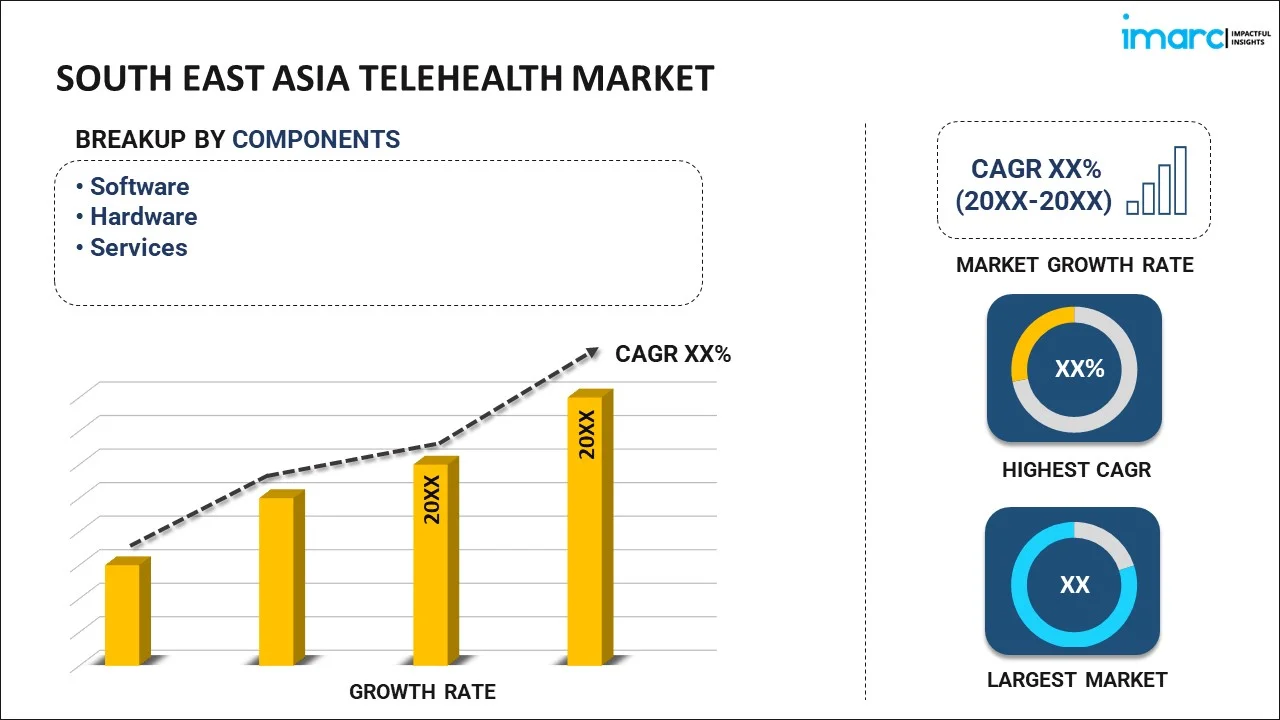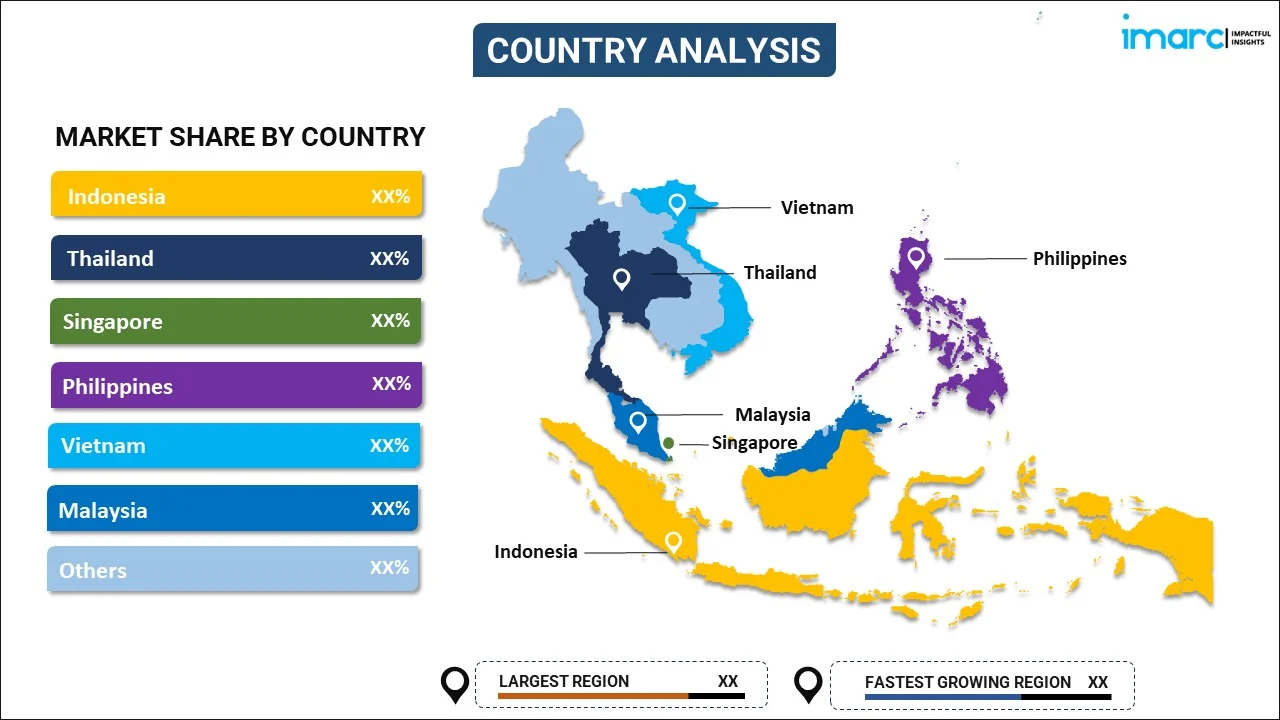
South East Asia Telehealth Market Report by Component (Software, Hardware, Services), Communication Technology (Video Conferencing, mHealth Solutions, and Others), Hosting Type (Cloud-Based and Web-based, On-Premises), Application (Teleconsultation and Telementoring, Medical Education and Training, Teleradiology, Telecardiology, Tele-ICU, Tele-Psychiatry, Tele-Dermatology, and Others), End-User (Providers, Patients, Payers, and Others), and Country 2025-2033
Market Overview:
South East Asia telehealth market size is projected to exhibit a growth rate (CAGR) of 27.55% during 2025-2033. The increasing demand for telehealth, which allows patients to consult with healthcare providers remotely, thereby improving access to medical expertise and reducing the need for in-person visits, is driving the market.
|
Report Attribute
|
Key Statistics
|
|---|---|
|
Base Year
|
2024 |
|
Forecast Years
|
2025-2033
|
|
Historical Years
|
2019-2024
|
| Market Growth Rate (2025-2033) | 27.55% |
Telehealth refers to the delivery of health-related services and information via telecommunications technologies. This rapidly evolving field encompasses various methods, including video conferencing, remote patient monitoring, and mobile health applications, enabling patients to access medical care virtually and healthcare providers to deliver services remotely. Telehealth facilitates real-time communication between patients and healthcare professionals, allowing for the diagnosis, treatment, and management of various health conditions from a distance. It has become increasingly significant in expanding access to healthcare, particularly in remote or underserved areas, and has proven instrumental in delivering timely and efficient care, reducing healthcare costs, and enhancing overall patient outcomes. As a result, telehealth has gained prominence as a means to ensure continuity of care while minimizing the risks associated with in-person visits, making it a vital component of modern healthcare delivery systems.
South East Asia Telehealth Market Trends:
The telehealth market in South East Asia has experienced an unprecedented surge primarily due to several key drivers. Firstly, the widespread adoption of digital technologies has significantly propelled the expansion of telehealth services. Consequently, this has enabled healthcare providers to reach a broader patient base, overcoming geographical barriers and enhancing accessibility, thus fostering market growth. Moreover, the escalating demand for remote healthcare services, particularly in rural and underserved areas, has catalyzed the market's progression. Consequently, healthcare organizations are increasingly integrating telehealth solutions into their existing systems, thereby augmenting the market's development. Additionally, the growing emphasis on cost-effective healthcare solutions has prompted both patients and healthcare providers to opt for telehealth services, leading to a reduction in overall healthcare costs and driving the market forward. Furthermore, the evolving regulatory landscape, with the introduction of supportive policies and reimbursement incentives that can incentivize the integration of telehealth solutions, is expected to drive the market in South East Asia during the forecast period.
South East Asia Telehealth Market Segmentation:
IMARC Group provides an analysis of the key trends in each segment of the market, along with forecasts at the country level for 2025-2033. Our report has categorized the market based on component, communication technology, hosting type, application, and end-user.
Component Insights:

- Software
- Hardware
- Services
The report has provided a detailed breakup and analysis of the market based on the component. This includes software, hardware, and services.
Communication Technology Insights:
- Video Conferencing
- mHealth Solutions
- Others
A detailed breakup and analysis of the market based on the communication technology have also been provided in the report. This includes video conferencing, mHealth solutions, and others.
Hosting Type Insights:
- Cloud-Based and Web-based
- On-Premises
The report has provided a detailed breakup and analysis of the market based on the hosting type. This includes cloud-based and web-based and on-premises.
Application Insights:
- Teleconsultation and Telementoring
- Medical Education and Training
- Teleradiology
- Telecardiology
- Tele-ICU
- Tele-Psychiatry
- Tele-Dermatology
- Others
A detailed breakup and analysis of the market based on the application have also been provided in the report. This includes teleconsultation and telementoring, medical education and training, teleradiology, telecardiology, tele-ICU, tele-psychiatry, tele-dermatology, and others.
End-User Insights:
- Providers
- Patients
- Payers
- Others
The report has provided a detailed breakup and analysis of the market based on the end-user. This includes providers, patients, payers, and others.
Country Insights:

- Indonesia
- Thailand
- Singapore
- Philippines
- Vietnam
- Malaysia
- Others
The report has also provided a comprehensive analysis of all the major regional markets, which include Indonesia, Thailand, Singapore, Philippines, Vietnam, Malaysia, and Others.
Competitive Landscape:
The market research report has also provided a comprehensive analysis of the competitive landscape. Competitive analysis such as market structure, key player positioning, top winning strategies, competitive dashboard, and company evaluation quadrant has been covered in the report. Also, detailed profiles of all major companies have been provided.
South East Asia Telehealth Market Report Coverage:
| Report Features | Details |
|---|---|
| Base Year of the Analysis | 2024 |
| Historical Period | 2019-2024 |
| Forecast Period | 2025-2033 |
| Units | Billion USD |
| Scope of the Report | Exploration of Historical and Forecast Trends, Industry Catalysts and Challenges, Segment-Wise Historical and Predictive Market Assessment:
|
| Components Covered | Software, Hardware, Services |
| Communication Technologies Covered | Video Conferencing, mHealth Solutions, Others |
| Hosting Types Covered | Cloud-Based and Web-based, On-Premises |
| Applications Covered | Teleconsultation and Telementoring, Medical Education and Training, Teleradiology, Telecardiology, Tele-ICU, Tele-Psychiatry, Tele-Dermatology, Others |
| End-Users Covered | Providers, Patients, Payers, Others |
| Countries Covered | Indonesia, Thailand, Singapore, Philippines, Vietnam, Malaysia, Others |
| Customization Scope | 10% Free Customization |
| Post-Sale Analyst Support | 10-12 Weeks |
| Delivery Format | PDF and Excel through Email (We can also provide the editable version of the report in PPT/Word format on special request) |
Key Questions Answered in This Report:
- How has the South East Asia telehealth market performed so far and how will it perform in the coming years?
- What has been the impact of COVID-19 on the South East Asia telehealth market?
- What is the breakup of the South East Asia telehealth market on the basis of component?
- What is the breakup of the South East Asia telehealth market on the basis of communication technology?
- What is the breakup of the South East Asia telehealth market on the basis of hosting type?
- What is the breakup of the South East Asia telehealth market on the basis of application?
- What is the breakup of the South East Asia telehealth market on the basis of end-user?
- What are the various stages in the value chain of the South East Asia telehealth market?
- What are the key driving factors and challenges in the South East Asia telehealth?
- What is the structure of the South East Asia telehealth market and who are the key players?
- What is the degree of competition in the South East Asia telehealth market?
Key Benefits for Stakeholders:
- IMARC’s industry report offers a comprehensive quantitative analysis of various market segments, historical and current market trends, market forecasts, and dynamics of the South East Asia telehealth market from 2019-2033.
- The research report provides the latest information on the market drivers, challenges, and opportunities in the South East Asia telehealth market.
- Porter's five forces analysis assist stakeholders in assessing the impact of new entrants, competitive rivalry, supplier power, buyer power, and the threat of substitution. It helps stakeholders to analyze the level of competition within the South East Asia telehealth industry and its attractiveness.
- Competitive landscape allows stakeholders to understand their competitive environment and provides an insight into the current positions of key players in the market.
Need more help?
- Speak to our experienced analysts for insights on the current market scenarios.
- Include additional segments and countries to customize the report as per your requirement.
- Gain an unparalleled competitive advantage in your domain by understanding how to utilize the report and positively impacting your operations and revenue.
- For further assistance, please connect with our analysts.
 Inquire Before Buying
Inquire Before Buying
 Speak to an Analyst
Speak to an Analyst
 Request Brochure
Request Brochure
 Request Customization
Request Customization




.webp)




.webp)












